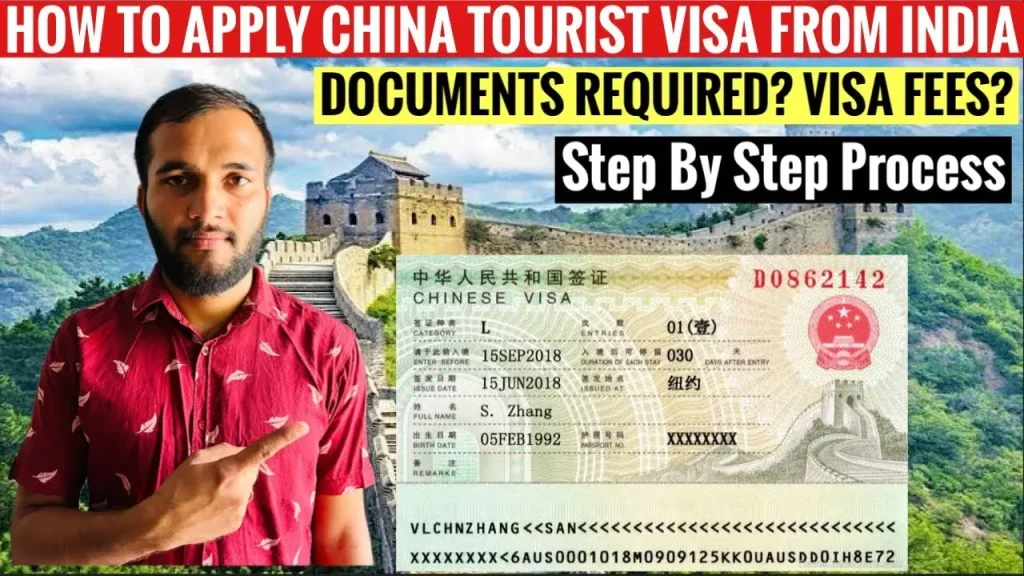India China tourist visas are back on the table after a five-year hiatus, heralding a new chapter in the historical ties between these two nations. The recent announcement, made by the Indian embassy in China, signifies a crucial shift towards restoring tourism between India and China, especially following a period marked by diplomatic tensions. In the wake of military clashes along their shared Himalayan border in 2020, both countries have sought to ameliorate their relations, and the issuance of Chinese tourist visas is a pivotal step in this process. As India opens its doors once again to visitors from China, potential travelers can look forward to exploring their rich cultural heritage and scenic landscapes. This renewed focus on visa issuance not only boosts bilateral tourism but also represents a broader commitment to enhancing India China relations, creating opportunities for cross-border travel and people-to-people connections.
The reopening of tourist visa options for travelers from China to India highlights a renewed focus on fostering cross-cultural connections between these two major Asian countries. Following a period of strained relations, characterized by military skirmishes and economic restrictions, the resumption of visa processing is a significant diplomatic breakthrough. Both nations seem eager to improve their rapport, allowing for greater tourism and mutual understanding through facilitated travel. This development is expected to encourage the flow of visitors and bolster economic ties, reflecting an optimistic outlook toward collaboration in the near future. With increasing dialogue on various fronts, including border negotiations and cultural exchanges, travelers from China can now make plans to immerse themselves in the vibrant diversity that India has to offer.
India Resumes Tourist Visa Issuance for Chinese Citizens
In a pivotal move towards improving India-China relations, the Indian government has announced the resumption of tourist visa issuance for Chinese citizens after a five-year hiatus. This decision was publicly communicated via the Indian embassy’s Weibo post, signaling a potential thaw in the previously tense dynamics between the two nations. The reinstatement of tourist visas marks a significant step in fostering tourism between India and China, which could lead to enhanced cultural exchange and economic cooperation in the long run.
Many experts believe that the reinstatement of visas could rejuvenate cross-border travel, which has been severely restricted since the military clashes in June 2020. This development not only symbolizes a willingness to mend relations but also highlights the importance both nations place on tourism as a means of bridging gaps stimulated by political tensions. As tourists from China begin to explore India once again, the potential for economic growth through tourism cannot be underestimated.
Impact of Visa Resumption on Tourism Between India and China
The resumption of tourist visas is expected to have a profound impact on tourism between India and China. Prior to the tensions, Chinese tourists were known to significantly contribute to India’s tourism sector, visiting various attractions such as the Taj Mahal, Rajasthan’s palaces, and the spiritual cities of Varanasi and Rishikesh. Their absence over the past five years has been keenly felt in terms of lost revenue and cultural exchange opportunities.
As travel restrictions ease, both countries can anticipate an influx of tourists engaging in various activities, ranging from pilgrimage tours to cultural exchanges. This resurgence can potentially stimulate local economies in India that rely heavily on tourism. Meanwhile, tourism agencies in China can also benefit from new travel packages tailored for Indian destinations, promoting a burgeoning interest in discovering India’s rich heritage and diversity.
Strengthening India-China Relations Through Tourism
The reintroduction of tourist visas is viewed not just as a travel facilitation measure but as a strategic effort to strengthen India-China relations. High-level meetings, including the recent discussions between President Xi Jinping and Prime Minister Narendra Modi, underscore a mutual understanding of the significance of tourism in diplomatic relations. These discussions have paved the way for a more cordial engagement between the nations, aiming to diminish the shadows of past disputes.
Through tourism, the two countries can foster people-to-people connections that enhance mutual understanding and goodwill. Such initiatives will play a crucial role in fostering a positive atmosphere for dialogue on more contentious issues, such as border disputes. By encouraging cross-border travel, both countries are signaling a commitment to focusing on shared interests, which can lead to long-term peace and collaboration.
The Future of Cross-Border Travel Between India and China
Looking ahead, the future of cross-border travel between India and China holds promise as diplomatic ties continue to strengthen. With both governments actively engaging in dialogue and collaboration, the potential for increased travel flows appears optimistic. Through trade, tourism, and cultural exchanges, both nations can work towards sustained improvements in bilateral relations.
Efforts to increase tourism will not only be advantageous for economic growth but may also serve as a platform for resolving outstanding issues. Future joint ventures, partnerships, and initiatives geared towards enhancing travel experiences will be instrumental in supporting the ongoing rapprochement. As both nations prioritize visa issuance and travel facilitation, they lay the groundwork for a more integrated and connected future.
Significance of Chinese Tourist Visas in Reestablishing Ties
The significance of issuing Chinese tourist visas extends beyond mere travel; it reflects a strategic approach to reestablishing diplomatic ties between India and China. The issuance of these visas showcases a commitment to engaging with each other constructively and facilitating meaningful exchanges that can unify two of Asia’s largest populations. The promise of accessible travel signals optimism about future diplomatic endeavors.
Furthermore, the process of applying for and receiving these tourist visas may become streamlined to cater to the growing interest among Chinese travelers. By reducing bureaucratic hurdles, both countries can encourage greater numbers of tourists, which will contribute significantly to their economies and foster long-term goodwill. The underlying goal is to convert tourism into a vehicle for deeper bilateral ties.
Visa Issuance as a Tool for Diplomatic Engagement
Visa issuance is often seen as a pragmatic tool for diplomatic engagement, and in this context, the restoration of tourist visas for Chinese citizens is a clear indicator of evolving relations. Recognizing the mutual benefits of tourism, both nations aim to use visa policies to create pathways for collaborative efforts in tourism promotion and cultural exchange.
This approach not only addresses current tensions but also establishes a foundation for constructive dialogue on various levels. By prioritizing tourism and easing visa restrictions, India and China can demonstrate their willingness to move past conflicts and focus on shared interests that promote regional stability.
Challenges and Opportunities in Visa Processing
While the resumption of tourist visas offers numerous opportunities, it also comes with challenges in terms of visa processing and regulatory compliance. Ensuring that the visa issuance system is efficient and user-friendly will be crucial in attracting Chinese tourists back to India. Adequate measures must be put in place to manage the demand while ensuring the safety and security of both nations.
On the other hand, this challenge provides an opportunity for innovation in the visa processing system. Both countries can explore modern technologies to streamline applications and approvals, enhancing the overall experience for travelers. By addressing hurdles proactively, India and China can better position themselves as attractive destinations for tourists from each side.
Cultural Exchange and Understanding Through Travel
The facilitation of tourist visas will enhance cultural exchange between India and China, allowing travelers to immerse themselves in each other’s rich histories and traditions. Such exchanges are essential for building empathy and understanding between the two nations, which have a long history of both cooperation and conflict. By visiting each other’s landmarks and participating in local customs, tourists can help break down stereotypes and foster goodwill.
Moreover, cultural understanding can transcend temporary political disagreements, creating lasting relationships among people. When citizens from one country engage with the other through travel, art, cuisine, and festivals, the foundation for deeper diplomatic ties is established, making it easier to address more challenging political issues down the line.
Enhancing Economic Ties Through Tourism Revenue
Tourism is a vital component of economic development, and the restoration of Chinese tourist visas stands to significantly impact economic ties between India and China. The influx of Chinese tourists could lead to increased revenue through expenditures on hospitality, transportation, and local attractions. This economic activity not only enriches local communities but also contributes to national revenues.
The tourism sector’s revitalization can also promote job creation in both countries, with potential opportunities arising in various related industries. By recognizing the importance of tourism as a linchpin for economic cooperation, both nations can strategically work to enhance tourism-related infrastructure and services, thereby solidifying economic interdependence.
Frequently Asked Questions
What are the requirements for obtaining an India China tourist visa?
To obtain an India China tourist visa, applicants need to provide a valid passport, recent photographs, proof of accommodation, a travel itinerary, and proof of financial means. It’s important to check for any additional requirements specific to Chinese citizens as visa issuance policies may vary.
How has the recent shift in India China relations affected tourist visa processes?
The recent improvement in India China relations has led to the resumption of tourist visas for Chinese citizens after a five-year hiatus. This indicates a more open approach to tourism between India and China, which may streamline visa issuance and promote cross-border travel.
How can I apply for a Chinese tourist visa for travel to India?
To apply for a Chinese tourist visa for travel to India, individuals must submit their application to the Chinese embassy or consulate, providing necessary documents including proof of accommodation in India, financial statements, and a travel itinerary. Ensure to check the latest visa guidelines as they can change with evolving India China relations.
What impact does military tension have on tourism between India and China?
Military tensions, such as those seen during the 2020 border clashes, can adversely affect tourism between India and China by leading to restrictions on visa issuance and travel bans. However, recent diplomatic engagements signal a hopeful turnaround, potentially easing access for travelers.
When did India resume tourist visa issuance for Chinese citizens?
India resumed issuing tourist visas to Chinese citizens on Thursday, as announced by the Indian embassy in China. This marked a significant shift in policy, reflecting improved diplomatic engagements and a desire to facilitate tourism between India and China.
What is the significance of the bilateral meetings between India and China for tourism?
Bilateral meetings between leaders such as China’s President Xi Jinping and India’s Prime Minister Narendra Modi are crucial in shaping the future of tourism between India and China. These discussions often address barriers to cross-border travel and can lead to collaborative initiatives, enhancing visa issuance policies.
Are there any specific travel restrictions for Chinese tourists visiting India?
Currently, with the resumption of tourist visas, there may be minimal restrictions for Chinese tourists visiting India. However, it’s vital to verify any health-related travel restrictions or requirements that may be in place due to changing global circumstances.
Can Chinese tourists apply for e-visa to visit India?
Yes, Chinese tourists can apply for an e-visa to visit India, provided they meet the eligibility criteria set by the Indian government. The e-visa facilitates the visa issuance process and encourages tourism between India and China.
What are the expected benefits of resumed tourism between India and China?
Resumed tourism between India and China is expected to bolster economic ties, enhance cultural exchanges, and improve people-to-people connections. Increased cross-border travel can benefit both nations’ economies and foster a more amicable relationship.
How do recent developments in India China relations influence tourist confidence?
Recent developments reflecting improved India China relations boost tourist confidence by ensuring travelers that there are open channels for communication and cooperation. This fosters a sense of security and encourages more tourists to explore travel opportunities between the two nations.
| Key Points |
|---|
| India resumes issuing tourist visas to Chinese citizens after five years. |
| The decision is a step towards de-escalating tensions between India and China. |
| Tensions escalated due to military clashes in June 2020 over their Himalayan border. |
| India implemented restrictions on Chinese investments and banned several Chinese applications post-clash. |
| High-level meetings between Indian and Chinese leaders are being held to rebuild relations. |
| China views India’s decision as a positive move for easing travel between the two countries. |
| Further discussions on border issues are planned between both nations later this year. |
Summary
India China tourist visas are back in operation, providing a fresh opportunity for travelers and marking a significant thaw in relations between India and China. The re-establishment of tourist visas comes after a prolonged period of strained ties following military conflicts over their shared border. This development not only facilitates travel but also represents a larger trend towards diplomatic rapprochement, with key leaders engaging in dialogue to enhance collaboration and resolve disputes. As both nations progress in their discussions, tourist-friendly initiatives are expected to contribute positively to mutual understanding and cultural exchange.



